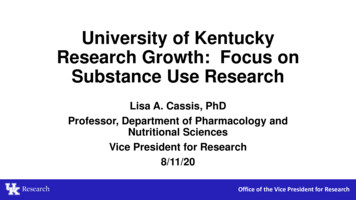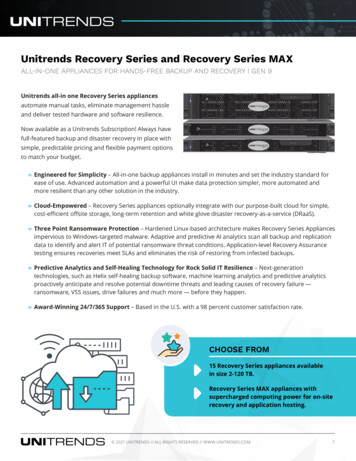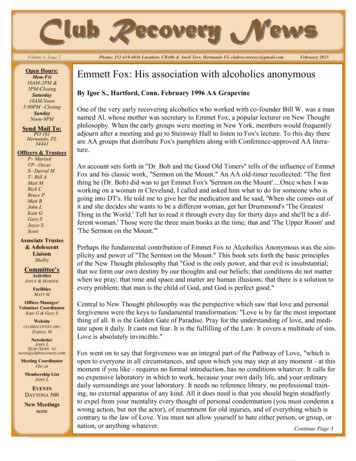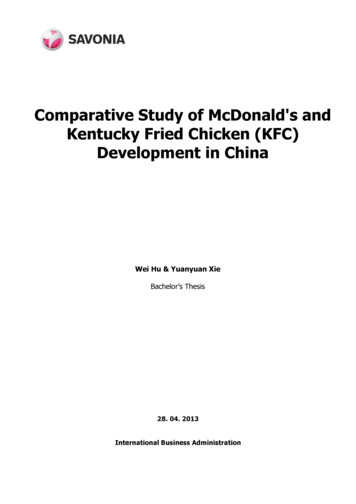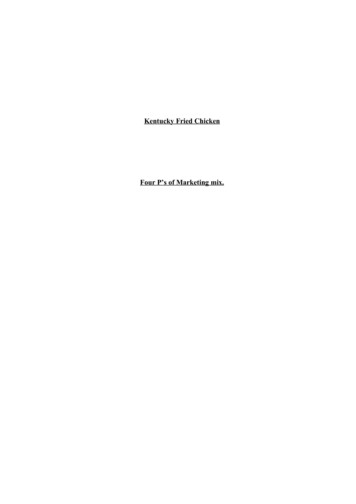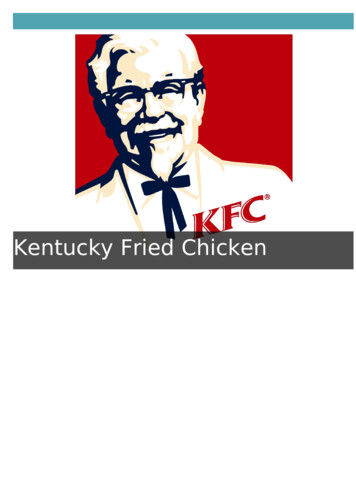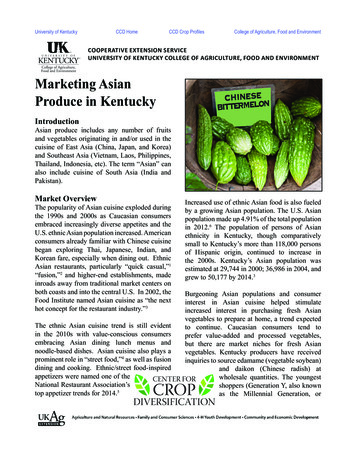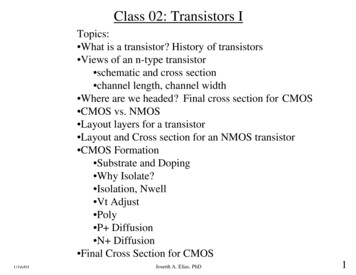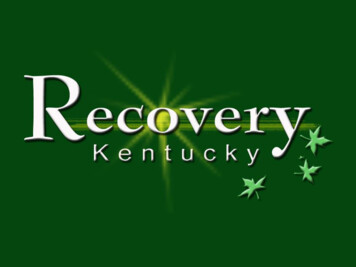
Transcription
What is Recovery Kentucky? Initiative to help Kentuckians recover from substanceabuse that often leads to chronic homelessness. Studies indicate that substance addiction is one ofthe leading causes of homelessness in theCommonwealth.
Who Will Be Served? Homeless At risk of homelessness Referrals from judicial system
LocationsBoonelembTriGainllatCarrollWomen kClark6LincolnRockcastleCaseyGreennBarrenBoyleTodd LoganSimpsonAllenBathCarterRow anBoydElliottLaw renceMenifee MorganJohnsonPow ellMartinMWolfeagMadison EstilloffinLeeFloydBreathittPikeFayettedAnJessanto Mercer mineginFlemingGreenuprdergBourbonrraCallow ayTrigglenbHartScottolasPulaskiAdair5Jackson Ow sleyLaurelClayPerry KnottLeslieRusselllfeHickman endenNelsonBreckinridgeDaviessUnionHarrison Nn t- yMomergoSpencerWebsterMShelbyLew isRobertson -Ow enWoodfordMen FacilitiesExisting de4PenHenry3HendersonllbempCa tonKenRecovery Kentucky10 Approved Recovery CentersWayneCumberWhitleyMonroe landClintonMcCrearyKnoxHarlanBellLetcher
Owensboro Regional RecoveryCenter for Men
Cumberland Hope Community Centerfor Women (Harlan County)
Owensboro Regional RecoveryCenter for Men Lobby
CenterPoint for Men (Paducah) SOSDorm Room
Cumberland Hope Community Center forWomen (Harlan Co.)Semi-Private Room
Liberty Place for WomenEntrance
Sober Living, Supportive Housing Model Self-help Education Personal accountability Community accountability Vocational support Positive behavior change
Recovery Kentucky Model Twelve Steps of Alcoholics Anonymous Recovery Dynamics Residents may live up to 24 months in supportivehousing recovery program
Recovery Kentucky Peer driven, but supervised by professionalstaff. Education and self-help programs helpresidents focus on internal changes inattitude, errors in thinking, and ultimatelybehavioral change that supports a drug-freelife.
Principles of a Social Model Program Peer Mentors and program participants help run theprogram with professional staff support Physical environment is home-like, not institutional.
Critical Elements of the Model 1. Guide & direct client through the 12 Steps 2.Teach “Recovery Dynamics” 3. Hybrid therapeutic community 4. Role model social skills & positive change 5. Accountability 24/7 self & others
Critical Elements 6. Keep focus on recovery first 7. Ownership of the disease 8. Empowerment/self-determination 9. Attraction 10. Self-governance 11. Peer teaching 12. Working with others
Critical Elements 13. Sharing experience, strength, & hope
Recovery CenterOutcome Study2017 Report
14 of the currently established Recovery Kentucky programsparticipate in the independently conducted RecoveryCenter Outcome Study (RCOS)Healing Place – Women’s ProgramWomen’s Addiction Recovery ManorCumberland Hope Community Center for WomenHope Center for WomenBrighton Recovery Center for WomenLiberty Place Recovery Center for WomenTrilogy Center for Women CenterPoint Recovery Center for MenGeorge Privett Recovery Center for MenMorehead Inspiration Center for MenOwensboro Regional Recovery Center for MenThe Healing Place of CampbellsvilleHealing Place – Men’s ProgramGrateful Life Center for Men
1,922intakes July2014 to June2015 (FY15)Intakes are collected atPhase I before entry intothe Recovery Center289follow-upsJuly 2015 toJune 2016(FY16)
Overall Client Characteristics(n 1922)
Referred by72.4%25%Self, Friends,Family referred15.5%Criminal justicesystemOn own9.7%Family, Friend, orPartner2.4%Other
Characteristics of all clients atintake (n hiteEducation41.5%Vocational/College18.2%No HS diploma/GED40.3%HS diploma/GED33 yearsMean Age(18-76)
Criminal Justice Involvement73.3%51.0%ArrestedIncarcerated
30 Day Substance Use79.0%56.4%Past 30 Day Use (N 1,039)AlcoholIllegal Drugs
Followed up sample (n 289)
REFERRAL51.2%Not DOC-referred48.8%Referred by DOCCharacteristicsof clients whowere followed-up(n 289)AVERAGE LENGTHOF SERVICE219days
Gender52.1%Characteristicsof clients whowere followed-up(n 289)47.9%33 yearsMean Age(19-70)Race5.5%Black2.5%Other92.0%White
Substance Use(past 6 months)Not in a Controlled Environment (n 263)
Substance Use(6 months before intake and follow-up)Any illegal drug useAny alcohol w-upintakefollow-up***p .001.
Substance Use(6 months before intake and follow-up)50.6%***49.4%***54.4%52.5%3.8%Alcohol to IntoxicationIntake***p .001.3.0%Binge DrinkingFollow-Up
Substance Use(past-30-day)Not in a Controlled Environment (n 164)
Substance Use(past 30 days at intake and follow-up)73.8%***81.1%57.3%***63.4%7.3%Any Illegal Drug UseIntake***p .001.Follow-Up6.1%AlcoholIntakeFollow-Up
Change in Self-Reported SubstanceUse Severity67.3%***80.5%***87.2%80.4%13.1%6.8%Alcohol Composite ScoreDrug Composite ScoreIndicative of Severe SUD (n Indicative of Severe SUD (n 107)133)Intake***p .001.Follow-Up
Multivariate analysisShorter length of service increased likelihood atfollow up of:SubstanceuseEmploymentCriminaljusticeLength of stayControl Variables:GenderDOC-referral statusMentalhealth drug/alcohol useIncarceration
Opioid versus Heroin
Substance Use(6 months before intake and follow-up)60.1%***64.3%38.0%***43.7%5.7%4.2%Opioid Use (excluding heroin)Intake***p .001.Follow-UpHeroin UseIntakeFollow-Up
Trend Alert12 months/6 months before entering the Recovery Center65%68%61%19%19%22%FY 2010FY 2011FY 2012Opioid56%29%FY 2013Heroin54%48%35%38%FY 2014FY 2015
Mental Health and Stress(past 6 months)
Mental Health(6 months before intake and ssion5.2%Generalized AnxietyIntake***p .001.65.4%***Follow-Up5.2%Comorbid Depressionand GeneralizedAnxiety
Mental Health(6 months before intake and follow-up)33.9%***34.6%0.7%Suicidal Thoughts or AttemptsIntake***p .001.Follow-Up
Days Health and Mental Health wasNot Good18.2104.10.9Number of Days in the Past 30 Days Number of Days in the Past 30 DaysPhysical Health Was Not GoodMental Health Was Not GoodIntakeFollow-UpAmerica’s Health Rankings: A Call to Action for Individuals and Their Communities. Retrieved fromhttp://www.americashealthrankings.org/KY.
Criminal Justice SystemInvolvement(past 6 months)
Involvement in the Criminal JusticeSystem from Intake to Follow-up52.2%69.4%of clientsreported at leastone arrest atintake50.9%******p .001.1.4%of clientsreported at leastone arrest atfollow-upof clients reported atleast one night ofincarceration at intake58.7%***10.8%of clients reported atleast one night ofincarceration atfollow-up
Living Situation andEconomic Hardship
Homelessness and Past-30-DayLiving ssIntake***p .001.Follow-UpOwn Home or Someone Else’s HomeIntakeFollow-Up
Difficulty in meeting needs forfinancial reasons42.0%***32.6%***50.0%37.2%8.0%4.5%Basic Living Needs (Food,Utilities, Shelter)Intake***p .001.Health Care NeedsFollow-Up
Education and Employment
Education3.7%**86.5%13.5%10.5%Less Than High SchoolDiploma or GEDIntake**p .01.89.5%Completed High SchoolDiploma/GED or MoreFollow-Up
Employment25.7%***79.5%53.8%Employed at Least One MonthIntake***p .001.
Recovery Support
Mutual Health Recovery tingsWent to Mutual Help MeetingsIntake***p .001.Follow-Up
Recovery Supportive Interactions18.3%***97.9%79.6%7average number ofpeople client couldcount on for supportat intake31average number ofpeople client couldcount on for supportat follow-upRecovery Supportive InteractionsWith Family/FriendsIntake***p .001.Follow-up
Return in Avoided Costs
Return on Investment in Recovery 2.71Estimated return foreach dollar investedExamining the total avoided costs in relation to expenditures on recovery services, it is estimated thatfor every dollar spent on recovery services, there was a 2.71 return in avoided costs.
Quality Of Life Ratings &Client Satisfaction
Overall Quality of Life***2.87.7Ratings were from 1 ‘Worst imaginable’ to 5 ‘Good and bad parts were about equal’ to 10 ‘Best imaginable’.***p .001.
Satisfaction with Life***8.417.9Ratings were from 1 ‘Extremely dissatisfied’ to 5 ‘Extremely satisfied’. Scale scores were a sum of the five items andranged from 5 which indicates the client is extremely dissatisfied with her current life to 25 which indicates theclient is highly satisfied with her life.***p .001.
Client Rating of Experience InRecovery Kentucky81.7%15.6%2.7%1 - WORST10 - BEST8.7
Conclusion
Significant Decreases InSubstance UseMental HealthCriminal JusticeInvolvementHomelessness
Significant increases inOverall Qualityof LifeLiving in OwnHomeRecoverySupportsEmployment
ConsiderationsMore men usealcohol atintakeFewer women areemployed at intake,make less than men atintake and follow-upWomen have moreanxiety, depressionand stress at intakeWomen have lowerquality of life, morenegative emotions, andless satisfaction withlife at intake
Limitations No random assignmentNo similar control groupSelf-selectionSelf-report
Thank YouFor more information contact:TK Logan, Ph.D. Professor,University of KentuckyCenter on Drug & Alcohol Researchtklogan@uky.edu(859) 257-8248http://cdar.uky.edu/bhos/
Spencer Simpson Shelby Scott Russell Row an Rock-castle-n Pulaski Pow ell Pike Perry n Ow sley Ow en Oldham Ohio s Nelson g Morgan t-y Monroe fe Mercer Meade Menifee McLean McCreary n . Liberty Place Recovery Center for Women Trilogy Center for Women CenterPoint Recovery Center for Men

